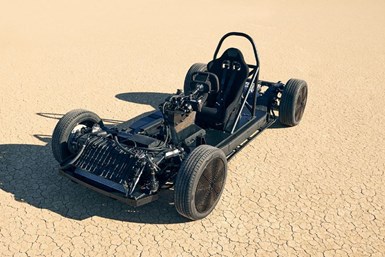Canoo Takes “Skatekart” EV Chassis for a Spin
Integrated design can accomodate 75% of today’s cars and commercial vehicles
It’s one thing to talk about the benefits of a dedicated electric vehicle skateboard platform. But it’s even more impressive to demonstrate the capabilities of the system.
That’s what California startup Canoo did in a new video.
Fun in the Sun
Race driver Sara Price put a stripped-down version of the architecture, which Canoo calls a “skatekart,” through its paces at Rabbit Dry Lake in Lucerne Valley, Calif.

Canoo EV skateboard chassis (Image: Canoo)
Here’s what she had to say: “I was blown away by how fun it was to drive. The overall performance was impressive.
“The skateboard felt powerful, with smooth and dynamic handling, especially during high speed cornering,” Price adds. “The drive-by-wire steering was something new for me and it felt like it was built for the track.”
What is It?
Canoo’s system houses an EV’s power and drivetrain components within the skateboard. In addition to the battery and electric motors, this includes the suspension and steering gear, as well as various control units, autonomous driving components and crash absorption structure.

The design frees up passenger space and makes it easier for Canoo to create a range of models by simply placing a new body on the skateboard with a seating position to match. Canoo claims the architecture can accommodate the needs of more than 75% of the most common passenger and light duty commercial vehicles on the road, providing the interior space of a large SUV with the exterior footprint of a compact car.
“We have revolutionized the platform design concept with a chassis that can be easily married with different cabins, with little adjustment, enabling us to get new vehicles on the road faster and cheaper,” explains Canoo founder and CEO Ulrich Kranz. “By keeping the most critical and expensive part of the vehicle uniform in all our models, it allows us to rapidly and cost effectively bring to market a full line-up of EVs.”
Powering Up
The platform can accommodate front, rear, or dual-motor powertrains.
The latter can produce 500 hp and 567 lb-ft of torque. Driving range is listed at more than 300 miles.
The motors have a peak efficiency of 97%, which Canoo notes makes them well-suited for urban driving cycles. The company developed all of the components itself.
By Wire
Canoo’s skateboard platform features what the company claims is the industry’s first true steer-by-wire system.
The technology eliminates the mechanical connection between the steering wheel and the road. It also does away with the steering rack that normally would protrude above the chassis.
During the California tests, Canoo demonstrated how the steering wheel can be moved to fit various cabin layouts and seating positions. This includes right-hand-drive configurations for delivery vehicles and future autonomous vehicle applications.
The steering system also has speed-sensitive power assist. Canoo says the lock-to-lock turning ratio can be customized based on application and user preference.
Double Wishbone
The suspension is a double-wishbone setup with two fiberglass transverse leaf springs, mounted transversely in the front and rear of the platform.
Mounting the dampers to the frame eliminates the need for large shock towers.
The integrated design keeps the entire suspension below the height of the tires.
What’s Next?
Canoo aims to introduce its first model, a van-like vehicle with a single motor, in Los Angeles in 2022.
Three other vehicles, including a series of delivery trucks and a sports car, are due in subsequent years.
Canoo says using a common platform will significantly reduce costs and speed development times, with derivative models requiring less than two years to bring to market. All vehicles will be sold on subscription plans.
RELATED CONTENT
-
On Fuel Cells, Battery Enclosures, and Lucid Air
A skateboard for fuel cells, building a better battery enclosure, what ADAS does, a big engine for boats, the curious case of lean production, what drivers think, and why Lucid is remarkable
-
On Automotive: An All Electric Edition
A look at electric vehicle-related developments, from new products to recycling old batteries.
-
Jeeps Modified for Moab
On Easter morning in Moab, Utah, when the population of that exceedingly-hard-to-get-to town in one of the most beautiful settings on Earth has more than doubled, some people won’t be hunting for Easter eggs, but will be trying to get a good look at one of the vehicles six that Jeep has prepared for real-life, fast-feedback from the assembled at the annual Easter Jeep Safari.








